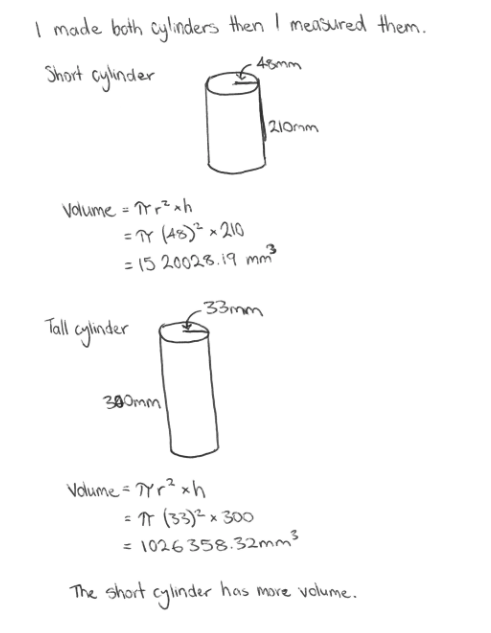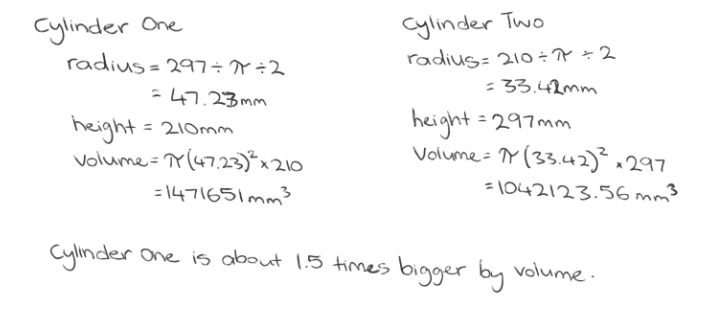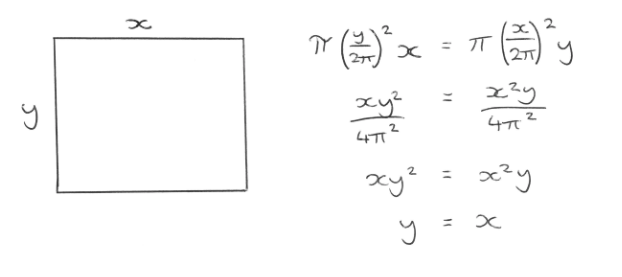The purpose of this activity is for students to create open cylinders and calculate their volume. In doing so students consider the relative effects of increasing and decreasing height and radius on the volume.
This activity assumes the students have experience in the following areas:
- Metric units of length, area, and volume.
- Conversions between common metric units for volume.
- Connections between radius, diameter, and circumference of a circle, including π.
- Calculation of volumes of prisms, and cylinders as a limiting case.
- Solving systems of algebraic equations with one or two unknowns (variables).
The problem is sufficiently open ended to allow the students freedom of choice in their approach. It may be scaffolded with guidance that leads to a solution, and/or the students might be given the opportunity to solve the problem independently.
The example responses at the end of the resource give an indication of the kind of response to expect from students who approach the problem in particular ways.
By rolling A4 sized rectangles of paper you can make two different ‘open’ cylinders, like this:

Which of the two cylinders has the greatest volume?
What sized rectangle of paper will produce cylinders with the same volume when rolled in this way?
The following prompts illustrate how this activity can be structured around the phases of the Mathematics Investigation Cycle.
Make sense
Introduce the problem. Allow students time to read it and discuss in pairs or small groups.
- Can I rephrase the problem in my own words?
- Can I imagine (visualise) what the numbers or shapes look like?
- Does this look/sound like a problem I have worked on before? (Has the student solved other problems with volume? What is meant by volume?)
- Where else in my life/the world can I see this happen? (Cylinders are common in real life, e.g., cans.)
- What information has been given?
- Is all this information needed?
- Is there anything missing?
Plan approach
Discuss ideas about how to solve the problem. Emphasise that, in the planning phase, you want students to say how they would solve the problem, not to actually solve it.
- What are the maths skills I need to work this out? (Students will need to know or find out how to find the volume of a cylinder.)
- What could the solution be? What is a sensible estimate? (Volumes need to be expressed using units of volume, e.g., cm3, m3. Which units will be useful in this problem?)
- What strategies can I use to get started? (Practically making the cylinders from A4 paper is a productive strategy.)
- What will I need to record as I work?
- What tools (digital or physical) could help my investigation?
Take action
Allow students time to work through their strategy and find a solution to the problem.
- Have I shown my workings in a step-by-step way?
- How can we share the mahi in our group to get the best result?
- Does my answer seem correct when I compare the cylinders to the volume of 1 litre (1000 cm3) cube? Is it close to my estimation?
- Is the result what I expected? Why or why not?
- Is there another possible answer or way to solve it? (Could using other units be more efficient?)
Convince yourself and others
Allow students time to check their answers and then either have them pair share with other groups or ask for volunteers to share their solution with the class.
- What is the solution?
- Can others see how I worked it out?
- Will one cylinder have more volume than the other as I alter the dimensions of the paper?
- What connections can I see to other situations, why would this be? (How might this relate to finding volumes of cones?)
- How will I convince others that my findings answer the investigation question?
Examples of work
Work sample 1
The student makes each cylinder and calculates the volumes using measurements.
Click on the image to enlarge it. Click again to close.
Work sample 2
The student applies relationships among the radius, diameter, and circumference of a circle, between side lengths of standard paper sizes, and conversions between units of volume.
Click on the image to enlarge it. Click again to close.
Cubic millimetres are awkward units for volume, so students may convert the measures to cubic centimetres.
Click on the image to enlarge it. Click again to close.
Algebra can also be used to prove that for the volumes of cylinders to be equal the length and width of the rectangle must be equal, i.e. the rectangle is a square.



